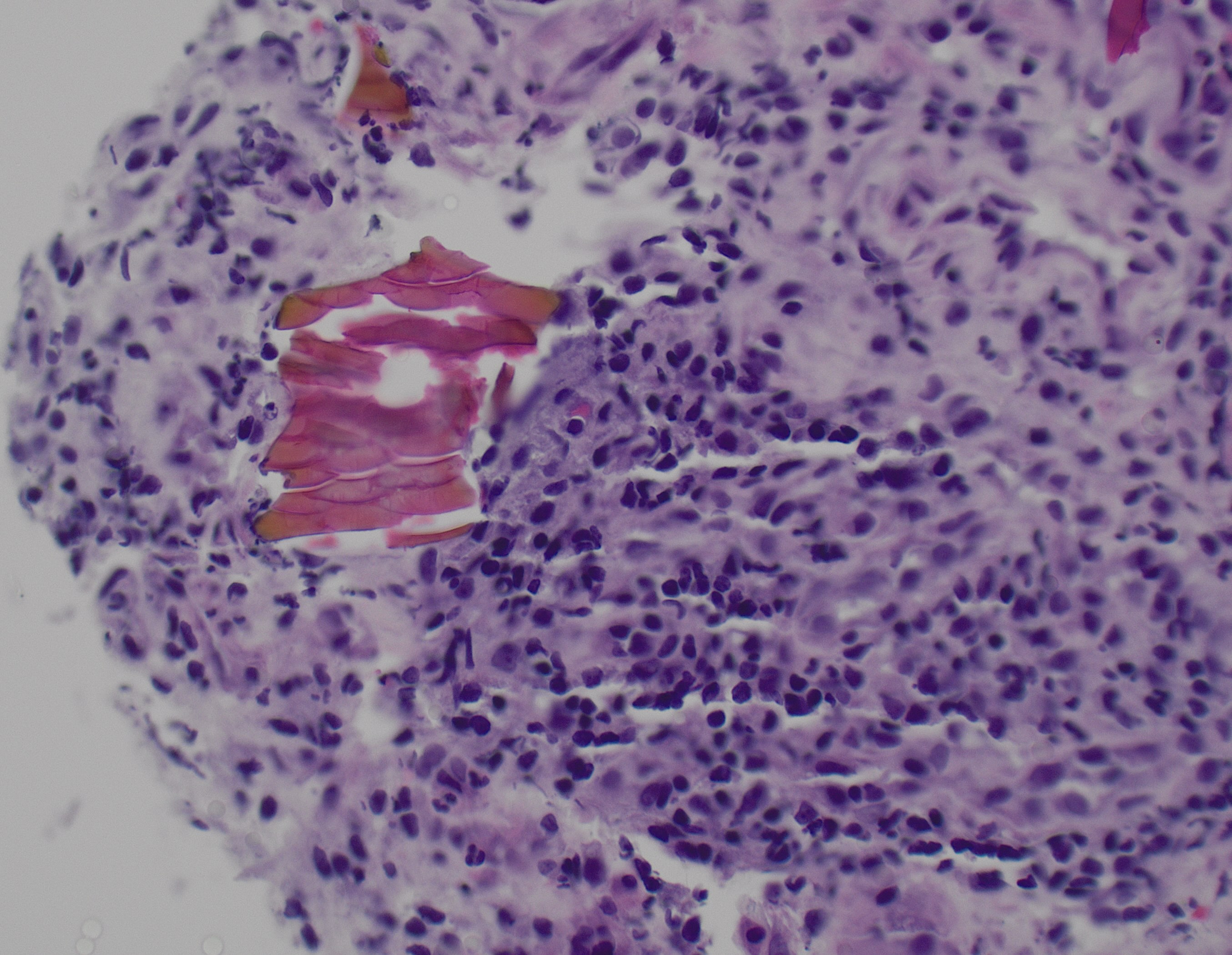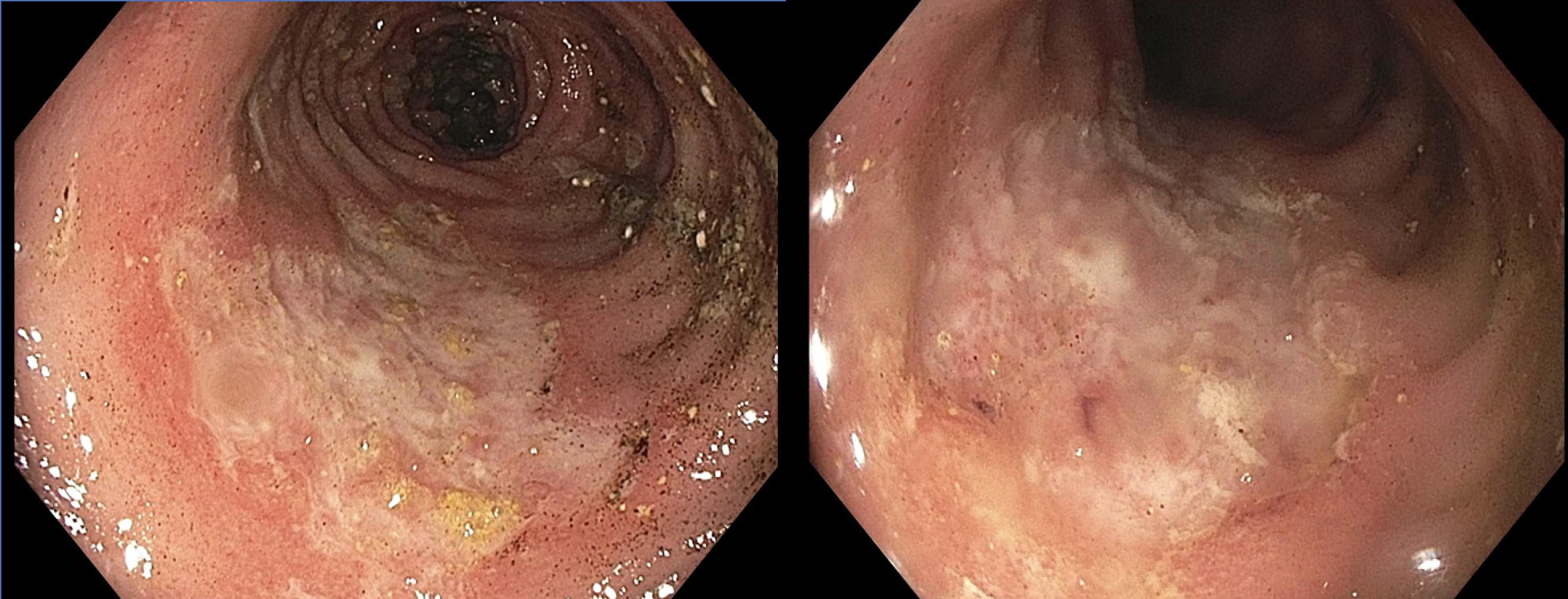Monday Poster Session
Category: GI Bleeding
P3111 - Hematochezia: A Rare Presentation of Sevelamer Toxicity
Monday, October 27, 2025
10:30 AM - 4:00 PM PDT
Location: Exhibit Hall

Robert Molina, MD, MPH
Baylor Scott & White Medical Center
Temple, TX
Presenting Author(s)
Robert Molina, MD, MPH1, Boris Zhong, DO1, Debby Rampisela, MD2, Christopher R. Naumann, MD1
1Baylor Scott & White Medical Center, Temple, TX; 2Baylor Scott & White, Temple, TX
Introduction: In patients with chronic kidney disease as well as those with end-stage renal disease, there are complications that arise due to decreased renal function such as hyperphosphatemia. Sevelamer is commonly prescribed in the management of hyperphosphatemia. Common side effects include nausea, dyspepsia, and diarrhea. Rare incidences of ileus, intestinal obstruction, and intestinal perforation have been reported. This case highlights a rare presentation of a patient who developed hematochezia due to ulcerations from Sevelamer crystallization and deposition into the wall of the GI tract.
Case Description/
Methods: A 70-year-old man presented for a 3-month history of intractable nausea, vomiting, weakness, dysphagia, and weight loss. He reported an episode of hematemesis, bloody bowel movement, and 2-3 episodes of gross hematuria. Labs were remarkable for HCO3 8, anion gap 44, BUN 281, phosphorus 17.19, creatinine 28.19, and hemoglobin 6.9. During his hospital stay, renal function worsened and he was initiated on CVVHD. He was started on Sevelamer for risk of refeeding syndrome and hyperphosphatemia. His course was complicated by DVT and a heparin drip was started. After starting heparin, his hemoglobin decreased and he required transfusions. The Gastroenterology team was consulted due to concerns of active bleeding. He underwent colonoscopy which revealed two colonic ulcers involving the ileocecal valve and ascending colon and two rectal ulcers. Biopsies from the ulcerations demonstrated Sevelamer crystals. The patient was transitioned to Phoslo with resolution of hematochezia.
Discussion: Sevelamer is a phosphate binder used in patients with chronic kidney disease and end-stage renal disease. Treatment of hyperphosphatemia in these patients is of utmost importance due to the potential negative side effects. Common presentations of Sevelamer induced gastrointestinal injury can range from abdominal pain to hematochezia, which happens to be the most common symptom leading to further evaluation. Although the mechanism for Sevelamer-induced gastrointestinal injury is not entirely understood, GI tract dysmotility and altered enzymatic secretion and absorption are thought to play contributing roles. This case highlights the importance of recognizing the possible severe side effects of medications, especially in patients who are critically ill, so that they may transition to another line of therapy.

Figure: Figure 1: Fish-scales, 2 toned with a pink center and yellow edges Sevelamer crystals (hematoxylin-eosin, original magnification x400).

Figure: Figure 2: Ulcerations identified during diagnostic colonoscopy.
Disclosures:
Robert Molina indicated no relevant financial relationships.
Boris Zhong indicated no relevant financial relationships.
Debby Rampisela indicated no relevant financial relationships.
Christopher Naumann indicated no relevant financial relationships.
Robert Molina, MD, MPH1, Boris Zhong, DO1, Debby Rampisela, MD2, Christopher R. Naumann, MD1. P3111 - Hematochezia: A Rare Presentation of Sevelamer Toxicity, ACG 2025 Annual Scientific Meeting Abstracts. Phoenix, AZ: American College of Gastroenterology.
1Baylor Scott & White Medical Center, Temple, TX; 2Baylor Scott & White, Temple, TX
Introduction: In patients with chronic kidney disease as well as those with end-stage renal disease, there are complications that arise due to decreased renal function such as hyperphosphatemia. Sevelamer is commonly prescribed in the management of hyperphosphatemia. Common side effects include nausea, dyspepsia, and diarrhea. Rare incidences of ileus, intestinal obstruction, and intestinal perforation have been reported. This case highlights a rare presentation of a patient who developed hematochezia due to ulcerations from Sevelamer crystallization and deposition into the wall of the GI tract.
Case Description/
Methods: A 70-year-old man presented for a 3-month history of intractable nausea, vomiting, weakness, dysphagia, and weight loss. He reported an episode of hematemesis, bloody bowel movement, and 2-3 episodes of gross hematuria. Labs were remarkable for HCO3 8, anion gap 44, BUN 281, phosphorus 17.19, creatinine 28.19, and hemoglobin 6.9. During his hospital stay, renal function worsened and he was initiated on CVVHD. He was started on Sevelamer for risk of refeeding syndrome and hyperphosphatemia. His course was complicated by DVT and a heparin drip was started. After starting heparin, his hemoglobin decreased and he required transfusions. The Gastroenterology team was consulted due to concerns of active bleeding. He underwent colonoscopy which revealed two colonic ulcers involving the ileocecal valve and ascending colon and two rectal ulcers. Biopsies from the ulcerations demonstrated Sevelamer crystals. The patient was transitioned to Phoslo with resolution of hematochezia.
Discussion: Sevelamer is a phosphate binder used in patients with chronic kidney disease and end-stage renal disease. Treatment of hyperphosphatemia in these patients is of utmost importance due to the potential negative side effects. Common presentations of Sevelamer induced gastrointestinal injury can range from abdominal pain to hematochezia, which happens to be the most common symptom leading to further evaluation. Although the mechanism for Sevelamer-induced gastrointestinal injury is not entirely understood, GI tract dysmotility and altered enzymatic secretion and absorption are thought to play contributing roles. This case highlights the importance of recognizing the possible severe side effects of medications, especially in patients who are critically ill, so that they may transition to another line of therapy.

Figure: Figure 1: Fish-scales, 2 toned with a pink center and yellow edges Sevelamer crystals (hematoxylin-eosin, original magnification x400).

Figure: Figure 2: Ulcerations identified during diagnostic colonoscopy.
Disclosures:
Robert Molina indicated no relevant financial relationships.
Boris Zhong indicated no relevant financial relationships.
Debby Rampisela indicated no relevant financial relationships.
Christopher Naumann indicated no relevant financial relationships.
Robert Molina, MD, MPH1, Boris Zhong, DO1, Debby Rampisela, MD2, Christopher R. Naumann, MD1. P3111 - Hematochezia: A Rare Presentation of Sevelamer Toxicity, ACG 2025 Annual Scientific Meeting Abstracts. Phoenix, AZ: American College of Gastroenterology.
